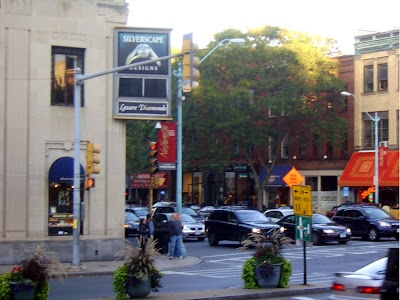From colonial times.
That ugly looking fence that restricted access to the front of Northampton's First Church has finally been removed as the roof replacement project of this summer has been completed at last.

On the steps of the church is this brass plaque turned green with age:
THE THIRD MEETING HOUSE
1737-1812
Here Rev. Jonathan Edwards preached
1727-1750
Who was Jonathan Edwards? He was a famous preacher of colonial times. According to this website:
In 1726, Edwards succeeded his grandfather, Solomon Stoddard, as the pastor of the church in Northampton, Massachusetts, the largest and most influential church outside of Boston. Turning his attention from the theoretical pursuits of his Yale years to more practical matters, he married Sarah Pierpont in 1727. Jonathan and Sarah had met in New Haven eight years earlier, when she was just thirteen years old, but they were not married until eight years later. The two of them would go on to raise ten children in Northampton.
Involved with a thirteen year old? Sheesh, why are these religious dudes always so pervy?
In 1734-1735, Edwards oversaw some of the initial stirrings of the First Great Awakening. He gained international fame as a revivalist and "theologian of the heart" after publishing A Faithful Narrative of the Surprising Work of God (1738), which described the awakening in his church and served as an empirical model for American and British revivalists alike.
According to this website, Edwards was a little nutty when it came to sin:
Jonathan Edwards was extremely conscious of every action or thought that might be sinful. He seemed to pay particular attention to his eating/drinking habits and would ration his intake of food to the minimum possible amount, even at the expense of his personal health. People that knew him often begged him to eat more because he typically looked very weak as if he were about to faint.
Here are some of the resolutions that I found particularly interesting:
Resolved, never to do any manner of thing, whether in soul or body, less or more, but what tends to the glory of God; nor be, nor suffer it, if I can avoid it.
Resolved, never to lose one moment of time; but improve it the most profitable way I possibly can.
Resolved, whenever I do any conspicuously evil action, to trace it back, till I come to the original cause; and then, both carefully endeavor to do so no more, and to fight and pray with all my might against the original of it.
Resolved, to examine carefully, and constantly, what that one thing in me is, which causes me in the least to doubt of the love of God; and to direct all my forces against it.
Resolved, to improve every opportunity, when I am in the best and happiest frame of mind, to cast and venture my soul on the Lord Jesus Christ, to trust and confide in him, and consecrate myself wholly to him; that from this I may have assurance of my safety, knowing that I confide in my Redeemer. July 8, 1723.
Sounds like the guy was on a crippling guilt trip! In any case his fame endures, as he can be seen competing with Cal Coolidge himself on the banner of the Northampton History Museum.

As so often happens to religious leaders, Edwards eventually got into trouble and was thrown out by his congregation.
In 1750, Edwards’ church dismissed him from Northampton after he attempted to impose stricter qualifications for admission to the sacraments upon his congregation. Concerned that the "open admission" policies instituted by Stoddard allowed too many hypocrites and unbelievers into church membership, he became embroiled in a bitter controversy with his congregation, area ministers, and political leaders.
His dismissal is often seen as a turning point in colonial American history because it marked the clear and final rejection of the old "New England Way" constructed by the Puritan settlers of New England. In her study of Northampton during Edwards' pastorate, Patricia Tracy described the social and political forces at work in the town as a reflection of larger economic, social and ideological forces then reshaping American culture. Ironically, then, the colonial theologian who best anticipated the intellectual shape of modern America also was its first victim.
Oh well, I guess his uptight religious era was over anyway. Here is the ancient stone the plaque refers to where the buckled shoes of the colonists once stepped on their way to hear Edwards preach.

I got a funny feeling when I stood on that spot and contemplated the generations upon generations of Pioneer Valley residents who have stepped on that stone.
The digital clock on the side of Silverscapes in Northampton has been broken the past several days. First the time was all screwed up, then it turned off completely.

I never appreciated how much I rely on that clock when I'm downtown until now that it's gone!
Meanwhile Zak at the Amherst Survival Center likes to do rude things with his dreads.





No comments:
Post a Comment